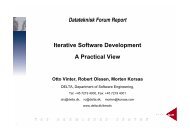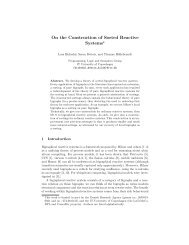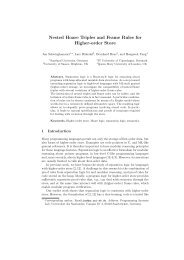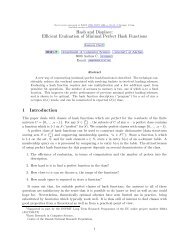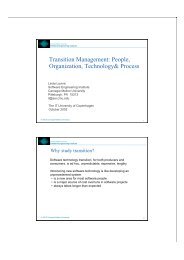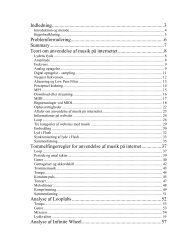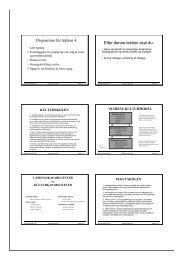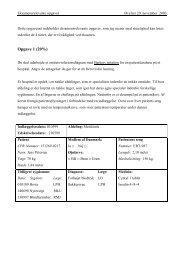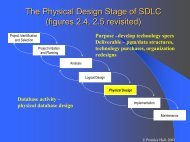Equivalence Checking of Combinational Circuits using ... - CiteSeerX
Equivalence Checking of Combinational Circuits using ... - CiteSeerX
Equivalence Checking of Combinational Circuits using ... - CiteSeerX
You also want an ePaper? Increase the reach of your titles
YUMPU automatically turns print PDFs into web optimized ePapers that Google loves.
TABLE IV<br />
RUNTIMES (IN CPU SECONDS) FOR VERIFYING EQUIVALENCE OF THE<br />
y<br />
REDUNDANT AND NON-REDUNDANT CIRCUITS IN THE ISCAS 85<br />
BENCHMARK WITHOUT PERFORMING OPERATOR REDUCTIONS.<br />
UP_ONE UP_ALL<br />
Circuit FANIN D._F. FANIN D._F.<br />
x<br />
x<br />
x<br />
x<br />
x<br />
x<br />
x<br />
x x x x<br />
c432/nr 2.9 2.6 2.5 2.3<br />
c499/nr 166.1 2.5 4.1<br />
c499/c1355 532.5 3.9 4.8<br />
c1355/nr 743.5 4.1 4.8<br />
c1908/nr 15.3 1.0 1.0<br />
c2670/nr 29.0 1.4 1.9<br />
c3540/nr 111.7 56.9 145.4<br />
c5315/nr 4.8 3.5 3.3<br />
c7552/nr 7.4 7.2 3.1 3.7<br />
c6288/nr<br />
c3540/nr_old 116.4 60.4 126.4<br />
c5315/nr_old 6.0 4.0 3.7<br />
c2670/nr_old 1.5<br />
c7552/nr_old 10.0 15.2 3.1 4.1<br />
<strong>of</strong> UP_ALL. This experiment indicates that performing an initial<br />
operator reduction step, as discussed in the introduction, can<br />
improve the time to construct an OBDD.<br />
B. The LGSynth 91 Benchmarks<br />
By construction, the redundant and non-redundant versions<br />
<strong>of</strong> the ISCAS 85 benchmark circuits have many structural similarities<br />
and are thus ideally suited for the BED approach.<br />
To test the verification strategy on a broader range <strong>of</strong> circuits<br />
with fewer structural similarities, we consider the circuits<br />
from the LGSynth 91 benchmark. This benchmark includes<br />
77 multi-level combinational circuits and 40 sequential<br />
circuits. These circuits are mapped to a gate library<br />
(msu.genlib) <strong>using</strong> SIS and then optimized for area <strong>using</strong> the<br />
SIS script script.algebraic. As mentioned above, there<br />
are two verification problems: one is to verify that the original<br />
circuits correspond to the mapped versions and one is to verify<br />
the mapped versions against the optimized versions. Due to the<br />
nature <strong>of</strong> the mapping and optimization steps, the circuits differ<br />
in structure considerably more than the ISCAS 85 circuits. The<br />
results for the 77 combinational circuits are shown graphically<br />
in Fig. 16. The eleven ISCAS 85 circuits are included in the<br />
LGSynth 91 benchmark and although some <strong>of</strong> the LGSynth 91<br />
circuits are considerably larger than the ISCAS 85 circuits, the<br />
ISCAS circuits are the most difficult ones to verify <strong>using</strong> the<br />
BED approach. The mapping <strong>of</strong> each circuit is verified in less<br />
than three minutes. The results for the verification <strong>of</strong> the optimization<br />
step are similar, except that the verification <strong>of</strong> the optimization<br />
step <strong>of</strong> C6288 failed <strong>using</strong> both UP_ONE and UP_ALL.<br />
The results for the verification <strong>of</strong> (the combinational portion<br />
<strong>of</strong>) the 40 sequential circuits in the LGSynth 91 benchmark are<br />
shown in Fig. 17. The mapping <strong>of</strong> the traditionally difficult circuit<br />
s38417 takes 20 minutes to verify and the verification <strong>of</strong><br />
mm9b fails for both variable ordering heuristics. The mapping <strong>of</strong><br />
the remaining 38 circuits is verified in less than one minute. The<br />
optimization <strong>of</strong> each circuit, except for mm9b and s38417, is<br />
also verified in less than one minute. The verification <strong>of</strong> mm9b<br />
and s38417 both fail when <strong>using</strong> 32 MB <strong>of</strong> memory. Using<br />
64 MB <strong>of</strong> memory, s38417 is verified in an hour <strong>using</strong> the<br />
FANIN ordering heuristic. The circuit mm9b is an instance where<br />
the two ordering heuristics fail to construct a good variable order,<br />
thus the verification <strong>of</strong> both the mapping and the optimization<br />
steps fail, even when <strong>using</strong> 64 MB <strong>of</strong> memory. Using the<br />
order in which the variables appear in the specification, the mapping<br />
<strong>of</strong> mm9b is verified <strong>using</strong> 64 MB <strong>of</strong> memory in 207 seconds<br />
and 270 seconds <strong>using</strong> UP_ONE and UP_ALL, respectively. Similarly,<br />
the optimization <strong>of</strong> mm9b is verified in 69 seconds and<br />
115 seconds <strong>using</strong> UP_ONE and UP_ALL, respectively.<br />
C. Comparisons <strong>of</strong> Results<br />
The ISCAS 85 benchmark has been used extensively by researchers<br />
to test techniques for solving the equivalence problem.<br />
Since all researchers have solved the exact same verification<br />
problems, there is a good basis for comparing the different<br />
approaches. Table V shows the runtimes to verify the ISCAS 85<br />
circuits <strong>using</strong> recent methods.<br />
The experiments are carried out on different machines and are<br />
therefore not directly comparable. However, the efficiency <strong>of</strong><br />
the machines only differ by a small constant and not by orders <strong>of</strong><br />
magnitude and therefore the comparisons still give a good indication<br />
<strong>of</strong> the relative virtues <strong>of</strong> the different approaches. The experiments<br />
<strong>of</strong> Brand [18] is an exception since he does not report<br />
runtimes for comparing the redundant and the non-redundant<br />
versions. Instead the circuits are synthesized and optimized,<br />
much in the same way as we have done for the LGSynth 91 circuits.<br />
This might well be a more difficult verification problem.<br />
From Table V it is clear that the learning-based approaches [21],<br />
TABLE V<br />
RUNTIMES (IN CPU SECONDS) OF OTHER APPROACHES FOR VERIFYING<br />
THE ISCAS 85 BENCHMARKS. NOTICE THAT THE RESULTS OF<br />
BRAND [18] ARE NOT DIRECTLY COMPARABLE SINCE A DIFFERENT<br />
VERIFICATION PROBLEM IS SOLVED. “N/A” DENOTES THAT THE RUNTIME<br />
HAS NOT BEEN REPORTED.<br />
Circuit BED [18] [21] [22] [24] [26] [45]<br />
c432/nr 2.1 4.0 1.0 2.0 0.8 0.2 0.4<br />
c499/nr 2.4 38.0 1.9 5.0 1.2 0.2 0.4<br />
c1355/nr 2.5 9.0 6.6 20.0 3.4 0.5 1.0<br />
c1908/nr 1.0 22.0 11.2 22.0 6.2 1.6 2.1<br />
c2670/nr 1.0 58.0 159.3 61.0 3.9 0.8 3.4<br />
c3540/nr 16.9 39.0 67.6 281.0 17.4 3.0 12.7<br />
c5315/nr 3.1 29.0 372.8 190.0 14.0 2.7 8.3<br />
c6288/nr 2.0 193.0 21.5 40.0 9.1 4.3 7.2<br />
c7552/nr 2.6 136.0 5583.3 412.0 20.6 34.6 20.8<br />
c1908/old 1.0 n/a n/a n/a n/a 2.5 n/a<br />
c2670/old 1.3 n/a n/a n/a n/a 54.6 n/a<br />
c3540/old 17.3 n/a n/a n/a n/a 2.9 n/a<br />
c5315/old 3.5 n/a n/a n/a n/a 8.3 n/a<br />
c7552/old 2.9 n/a n/a n/a n/a 26.2 n/a<br />
[22] are inefficient for larger circuits. The runtimes <strong>of</strong> the BED<br />
approach is generally comparable to (and sometimes better than)<br />
the other three approaches [24], [26], [45]. Moreover, these runtimes<br />
should be seen in the light <strong>of</strong> the fact that the BED experiments<br />
only use 32 MB <strong>of</strong> memory.<br />
Only van Eijk [26] has reported runtimes for the erroneous<br />
ISCAS 85 circuits. For these circuits it is observed that the BED



